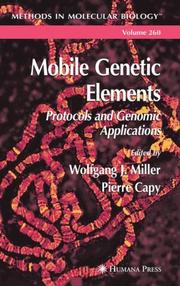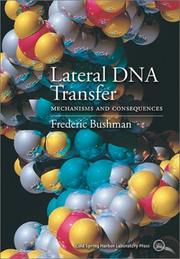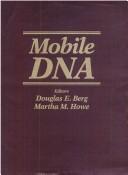| Listing 1 - 10 of 12 | << page >> |
Sort by
|
Book
ISBN: 9781621000228 1621000222 9781614709589 1614709580 Year: 2011 Publisher: Hauppauge, N.Y. : Nova Science,
Abstract | Keywords | Export | Availability | Bookmark
 Loading...
Loading...Choose an application
- Reference Manager
- EndNote
- RefWorks (Direct export to RefWorks)
Mobile genetic elements. --- Genetic elements, Mobile --- Genetic mobile elements --- Mobile DNA --- Mobile DNA sequences --- Mobile elements, Genetic --- DNA --- Molecular genetics
Book
Abstract | Keywords | Export | Availability | Bookmark
 Loading...
Loading...Choose an application
- Reference Manager
- EndNote
- RefWorks (Direct export to RefWorks)
The human genome, as with the genome of most organisms, is comprised of various types of mobile genetic element derived repeats. Mobile genetic elements that mobilize by an RNA intermediate, include both autonomous and non-autonomous retrotransposons, and mobilize by a “copy and paste” mechanism that relies of the presence of a functional reverse transcriptase activity. The extent to which these different types of elements are actively mobilizing varies among organisms, as revealed with the advent of Next Generation DNA sequencing (NGS).To understand the normal and aberrant mechanisms that impact the mobility of these elements requires a more extensive understanding of how these elements interact with molecular pathways of the cell, including DNA repair, recombination and chromatin. In addition, epigenetic based-mechanisms can also influence the mobility of these elements, likely by transcriptional activation or repression in certain cell types. Studies regarding how mobile genetic elements interface and evolve with these pathways will rely on genomic studies from various model organisms. In addition, the mechanistic details of how these elements are regulated will continue to be elucidated with the use of genetic, biochemical, molecular, cellular, and bioinformatic approaches. Remarkably, the current understanding regarding the biology of these elements in the human genome, suggests these elements may impact developmental biology, including cellular differentiation, neuronal development, and immune function. Thus, aberrant changes in these molecular pathways may also impact disease, including neuronal degeneration, autoimmunity, and cancer.
transposon --- genome stability --- model organisms --- reverse transcriptase --- Mobile DNA --- RNA-dependent DNA polymerase --- cellular differentiation --- retrotransposon --- DNA repair --- transposon --- genome stability --- model organisms --- reverse transcriptase --- Mobile DNA --- RNA-dependent DNA polymerase --- cellular differentiation --- retrotransposon --- DNA repair
Book
Abstract | Keywords | Export | Availability | Bookmark
 Loading...
Loading...Choose an application
- Reference Manager
- EndNote
- RefWorks (Direct export to RefWorks)
The human genome, as with the genome of most organisms, is comprised of various types of mobile genetic element derived repeats. Mobile genetic elements that mobilize by an RNA intermediate, include both autonomous and non-autonomous retrotransposons, and mobilize by a “copy and paste” mechanism that relies of the presence of a functional reverse transcriptase activity. The extent to which these different types of elements are actively mobilizing varies among organisms, as revealed with the advent of Next Generation DNA sequencing (NGS).To understand the normal and aberrant mechanisms that impact the mobility of these elements requires a more extensive understanding of how these elements interact with molecular pathways of the cell, including DNA repair, recombination and chromatin. In addition, epigenetic based-mechanisms can also influence the mobility of these elements, likely by transcriptional activation or repression in certain cell types. Studies regarding how mobile genetic elements interface and evolve with these pathways will rely on genomic studies from various model organisms. In addition, the mechanistic details of how these elements are regulated will continue to be elucidated with the use of genetic, biochemical, molecular, cellular, and bioinformatic approaches. Remarkably, the current understanding regarding the biology of these elements in the human genome, suggests these elements may impact developmental biology, including cellular differentiation, neuronal development, and immune function. Thus, aberrant changes in these molecular pathways may also impact disease, including neuronal degeneration, autoimmunity, and cancer.
transposon --- genome stability --- model organisms --- reverse transcriptase --- Mobile DNA --- RNA-dependent DNA polymerase --- cellular differentiation --- retrotransposon --- DNA repair
Book
Abstract | Keywords | Export | Availability | Bookmark
 Loading...
Loading...Choose an application
- Reference Manager
- EndNote
- RefWorks (Direct export to RefWorks)
The human genome, as with the genome of most organisms, is comprised of various types of mobile genetic element derived repeats. Mobile genetic elements that mobilize by an RNA intermediate, include both autonomous and non-autonomous retrotransposons, and mobilize by a “copy and paste” mechanism that relies of the presence of a functional reverse transcriptase activity. The extent to which these different types of elements are actively mobilizing varies among organisms, as revealed with the advent of Next Generation DNA sequencing (NGS).To understand the normal and aberrant mechanisms that impact the mobility of these elements requires a more extensive understanding of how these elements interact with molecular pathways of the cell, including DNA repair, recombination and chromatin. In addition, epigenetic based-mechanisms can also influence the mobility of these elements, likely by transcriptional activation or repression in certain cell types. Studies regarding how mobile genetic elements interface and evolve with these pathways will rely on genomic studies from various model organisms. In addition, the mechanistic details of how these elements are regulated will continue to be elucidated with the use of genetic, biochemical, molecular, cellular, and bioinformatic approaches. Remarkably, the current understanding regarding the biology of these elements in the human genome, suggests these elements may impact developmental biology, including cellular differentiation, neuronal development, and immune function. Thus, aberrant changes in these molecular pathways may also impact disease, including neuronal degeneration, autoimmunity, and cancer.
transposon --- genome stability --- model organisms --- reverse transcriptase --- Mobile DNA --- RNA-dependent DNA polymerase --- cellular differentiation --- retrotransposon --- DNA repair
Periodical
ISSN: 2159256X 21592543 Year: 2011 Publisher: Austin, TX : Landes Bioscience
Abstract | Keywords | Export | Availability | Bookmark
 Loading...
Loading...Choose an application
- Reference Manager
- EndNote
- RefWorks (Direct export to RefWorks)
Mobile genetic elements --- DNA --- DNA. --- Mobile genetic elements. --- Genetic elements, Mobile --- Genetic mobile elements --- Mobile DNA --- Mobile DNA sequences --- Mobile elements, Genetic --- Deoxyribonucleic acid --- Desoxyribonucleic acid --- Thymonucleic acid --- TNA (Nucleic acid) --- Molecular genetics --- Deoxyribose --- Nucleic acids --- Genes --- Genetics --- Éléments génétiques mobiles --- ADN

ISBN: 1588290077 9786610360437 1280360437 1592597556 Year: 2004 Publisher: Totowa, NJ : Humana Press : Imprint: Humana,
Abstract | Keywords | Export | Availability | Bookmark
 Loading...
Loading...Choose an application
- Reference Manager
- EndNote
- RefWorks (Direct export to RefWorks)
Transposable elements (TEs)-DNA sequences that are capable of moving from one chromosome location to another-are found in all living organisms. They have been increasingly investigated in a wide spectrum of species, including bacteria, plants, fungi, and animals. In Mobile Genetic Elements: Protocols and Genomic Applications, leading experts describe in step-by-step detail their most productive transposon-based methods and strategies for studying genome structure, function, and evolution. These readily reproducible techniques cover a broad range, including mutagenesis, transgenesis, gene silencing, and molecular systematics. Among the highlights are a series of DNA hybridization methods for analyzing the distribution and dynamics of mobile DNA at the hosts' genomic level, techniques for studying LTR retrotransposons in heterologous host systems, and mutagenesis protocols for investigating gene functions in a broad range of organisms. Additional methods deal with highly informative sets of polymorphic markers, RNAi technology in gene silencing, and applications during transgenesis. The protocols presented follow the successful Methods in Molecular Biology™ series format, each one offering step-by-step laboratory instructions, an introduction outlining the principle behind the technique, lists of equipment and reagents, and tips on troubleshooting and avoiding known pitfalls. State-of-the-art and highly practical, Mobile Genetic Elements: Protocols and Genomic Applications offers investigators powerful genetic tools for dissecting the function of a specific gene, elaborating on the mechanisms leading to genetic change and diversity, and studying the evolutionary impact of mobile DNA on the biology and evolution of organisms.
Genomics --- Interspersed Repetitive Sequences --- Mobile genetic elements --- Molecular biology --- Sequence Analysis --- Methods --- Molecular genetics. --- Genetics --- Genetic elements, Mobile --- Genetic mobile elements --- Mobile DNA --- Mobile DNA sequences --- Mobile elements, Genetic --- DNA --- Molecular genetics --- Human genetics. --- Human Genetics. --- Heredity, Human --- Human biology --- Physical anthropology

ISBN: 0879696036 0879696214 9780879696030 Year: 2002 Publisher: Cold Spring Harbor : Cold Spring Harbor Laboratory Press [C.S.H.L.],
Abstract | Keywords | Export | Availability | Bookmark
 Loading...
Loading...Choose an application
- Reference Manager
- EndNote
- RefWorks (Direct export to RefWorks)
Transfection --- Transposons --- Mobile genetic elements --- Interspersed Repetitive Sequences --- Eléments génétiques mobiles --- Séquences répétées dispersées --- Transfert de gène --- Gene transfer --- Mobile genetic elements. --- Transposons. --- Transfection. --- Genetic transformation --- Viral genetics --- Tn elements --- Transposable elements --- Genetic elements, Mobile --- Genetic mobile elements --- Mobile DNA --- Mobile DNA sequences --- Mobile elements, Genetic --- Eléments génétiques mobiles --- Séquences répétées dispersées --- Nucleic acids --- DNA --- Molecular genetics --- ADN --- DNA Transposable Elements --- DNA. --- GENOMES --- GENE TRANSFER --- MONOGRAPHS --- EVOLUTION

ISBN: 1555810055 9781555810054 Year: 1989 Publisher: Washington, DC : ASM [American Society for Microbiology],
Abstract | Keywords | Export | Availability | Bookmark
 Loading...
Loading...Choose an application
- Reference Manager
- EndNote
- RefWorks (Direct export to RefWorks)
Cell physiology --- Insertion elements, DNA --- Recombinant DNA --- Mobile genetic elements --- Cellules --- Eléments transposables (Génétique) --- ADN recombinant --- Eléments génétiques mobiles --- Physiologie --- Prokaryotic Cells --- DNA, Recombinant --- Eukaryotic Cells --- Cell Physiological Phenomena --- DNA Transporsable Elements --- physiology --- 575.08:577.21 --- 579.254 --- 579.25 --- Genetic elements, Mobile --- Genetic mobile elements --- Mobile DNA --- Mobile DNA sequences --- Mobile elements, Genetic --- DNA --- Molecular genetics --- Genetic engineering, genetic manipulation, recombinant DNA --- Genetic exchange. Genetic transmission --- Microbial genetics --- Mobile genetic elements. --- 579.25 Microbial genetics --- 579.254 Genetic exchange. Genetic transmission --- 575.08:577.21 Genetic engineering, genetic manipulation, recombinant DNA --- Eléments transposables (Génétique) --- Eléments génétiques mobiles --- DNA, Recombinant. --- DNA, Recombinant - physiology --- Genetic elements
Periodical
Abstract | Keywords | Export | Availability | Bookmark
 Loading...
Loading...Choose an application
- Reference Manager
- EndNote
- RefWorks (Direct export to RefWorks)
DNA --- Molecular genetics --- Mobile genetic elements --- ADN --- Génétique moléculaire --- Eléments génétiques mobiles --- Periodicals --- Périodiques --- Genomics --- Genomics. --- Sequence Analysis, DNA. --- Mobile genetic elements. --- Genetic elements, Mobile --- Genetic mobile elements --- Mobile DNA --- Mobile DNA sequences --- Mobile elements, Genetic --- Genome research --- Genomes --- Analysis, DNA Sequence --- DNA Sequence Determination --- DNA Sequence Determinations --- DNA Sequencing --- Determination, DNA Sequence --- Determinations, DNA Sequence --- Sequence Determinations, DNA --- DNA Sequence Analysis --- Sequence Determination, DNA --- Analyses, DNA Sequence --- DNA Sequence Analyses --- Sequence Analyses, DNA --- Sequencing, DNA --- Research --- DNA rearrangements --- DNA recombination --- Molecular Sequence Annotation --- Human Genome Project --- Genome --- DNA. --- Comparative Genomics --- Comparative Genomic --- Genomic, Comparative --- Genomics, Comparative --- Genetics --- dna rearrangements --- dna recombination --- Elements genètics mòbils. --- ADN.
Book
Year: 2020 Publisher: Basel, Switzerland MDPI - Multidisciplinary Digital Publishing Institute
Abstract | Keywords | Export | Availability | Bookmark
 Loading...
Loading...Choose an application
- Reference Manager
- EndNote
- RefWorks (Direct export to RefWorks)
Many biodegradation pathways, both aerobic and anaerobic, have already been characterised, and the phylogenetic relationships among catabolic genes within them have been studied. However, new biodegradation activities and their coding genes are continuously being reported, including those involved in the catabolism of emerging contaminants and those generally regarded as non-biodegradable. Gene regulation is also an important issue for the efficient biodegradation of contaminants. Specific induction by the substrate and over-imposed global regulatory networks adjust the expression of the biodegradation genes to meet bacterial physiological needs. New biodegradation pathways can be assembled in a particular strain or in a bacterial consortium by recruiting biodegradation genes from different origins through horizontal gene transfer. The abundance and diversity of biodegradation genes, analysed by either genomic or metagenomic approaches, constitute valuable indicators of the biodegradation potential of a particular environmental niche. This knowledge paves the way to systems metabolic engineering approaches to valorise biowaste for the production of value-added products.
Research & information: general --- Biology, life sciences --- tetralin --- Sphingopyxis granuli strain TFA --- Rhodococcus sp. strain TFB --- redox proteins --- carbon catabolite repression --- plastics --- biodegradation --- sustainability --- upcycling --- biotransformations --- polyethylene terephthalate --- terephthalate --- ethylene glycol --- biphenyl --- bph gene --- integrative conjugative element --- genome sequence --- LysR --- transcription factor --- Acinetobacter --- LTTR --- benzoate --- muconate --- synergism --- biosensor --- naphthalene --- toluene --- hydrocarbons --- plant growth promotion --- bioremediation --- Pseudomonas --- soil pollution --- phytoremediation --- rhizoremediation --- diesel --- bacteria --- consortium --- metagenomics --- PAHs --- TPH --- regulation --- anaerobic --- Azoarcus --- promoter architecture --- bioethanol --- furfural --- ALE --- AraC --- sterols --- bile acids --- steroid hormones --- 9,10-seco pathway --- 4,5-seco pathway --- 2,3-seco pathway --- xenobiotics --- Carbaryl --- horizontal gene transfer --- mobile genetic elements --- transposons --- integrative conjugative elements --- pathway assembly --- evolution --- Sphingopyxis lindanitolerans --- pesticide --- complete genome sequence --- pangenome --- γ-HCH degradation --- lin genes --- testosterone --- steroid --- catabolism --- transcriptomic --- valorisation --- catabolic pathway --- mobile DNA --- anaerobic biodegradation --- gene regulation --- tetralin --- Sphingopyxis granuli strain TFA --- Rhodococcus sp. strain TFB --- redox proteins --- carbon catabolite repression --- plastics --- biodegradation --- sustainability --- upcycling --- biotransformations --- polyethylene terephthalate --- terephthalate --- ethylene glycol --- biphenyl --- bph gene --- integrative conjugative element --- genome sequence --- LysR --- transcription factor --- Acinetobacter --- LTTR --- benzoate --- muconate --- synergism --- biosensor --- naphthalene --- toluene --- hydrocarbons --- plant growth promotion --- bioremediation --- Pseudomonas --- soil pollution --- phytoremediation --- rhizoremediation --- diesel --- bacteria --- consortium --- metagenomics --- PAHs --- TPH --- regulation --- anaerobic --- Azoarcus --- promoter architecture --- bioethanol --- furfural --- ALE --- AraC --- sterols --- bile acids --- steroid hormones --- 9,10-seco pathway --- 4,5-seco pathway --- 2,3-seco pathway --- xenobiotics --- Carbaryl --- horizontal gene transfer --- mobile genetic elements --- transposons --- integrative conjugative elements --- pathway assembly --- evolution --- Sphingopyxis lindanitolerans --- pesticide --- complete genome sequence --- pangenome --- γ-HCH degradation --- lin genes --- testosterone --- steroid --- catabolism --- transcriptomic --- valorisation --- catabolic pathway --- mobile DNA --- anaerobic biodegradation --- gene regulation
| Listing 1 - 10 of 12 | << page >> |
Sort by
|

 Search
Search Feedback
Feedback About UniCat
About UniCat  Help
Help News
News